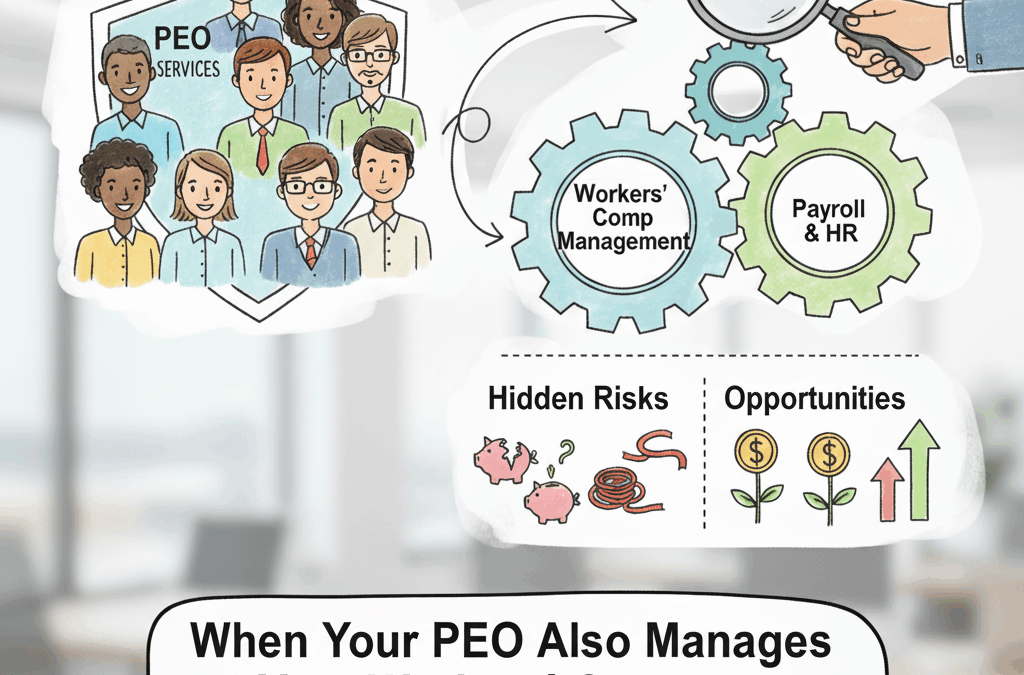Introduction
Partnering with a Professional Employer Organization (PEO) can be a smart move for businesses looking to simplify HR operations. From payroll and benefits to compliance and employee relations, PEOs offer valuable support that allows leaders to focus on growth instead of administrative tasks.
But when a PEO also manages your workers’ compensation insurance, the relationship becomes more complex. Workers’ compensation isn’t just another compliance box to check it’s a financial and legal safeguard that touches your people, your risk profile, and your bottom line.
Understanding how PEOs handle workers’ compensation can help businesses avoid costly surprises and make smarter, more strategic decisions about coverage, claims, and safety culture.
1. How PEOs Manage Workers’ Compensation
In most PEO partnerships, the organization acts as a co-employer, sharing certain legal responsibilities with the client company. This allows the PEO to include your employees in its master workers’ compensation policy.
The arrangement can bring advantages like access to lower insurance rates, streamlined claims handling, and expert risk management. By pooling multiple clients under one policy, PEOs often negotiate better premiums than a small business could secure on its own.
However, this shared model also means shared responsibility. Your company’s claim history, safety record, and workplace culture all contribute to the overall risk pool. In some cases, the behaviour or claims of other businesses within that pool can influence your premiums, too.
2. The Hidden Risks Behind Shared Coverage
While the convenience of bundled coverage is appealing, it can obscure important details that impact cost and control.
One major concern is transparency. When a PEO handles all workers’ comp claims under its own policy, the client company may not have full visibility into claim data, reserve amounts, or the factors driving rate changes. That lack of insight can make it difficult to plan budgets, identify safety issues, or verify that claims are being handled fairly.
Another hidden risk is loss of experience credit. If you ever decide to leave your PEO, your claims history might not transfer to your new insurer. Without that history, you could lose the positive experience rating you’ve earned through safe operations—meaning higher premiums down the road.
Lastly, businesses must be aware of coverage boundaries. Some PEOs offer limited protection for certain job types, remote workers, or high-risk roles. Understanding exactly who and what is covered is critical before signing any agreement.
3. The Opportunities in Partnership
Despite these risks, a well-chosen PEO can provide real strategic advantages. Their expertise in safety programs, claims management, and regulatory compliance can dramatically reduce your exposure to costly incidents.
Top-tier PEOs use data-driven safety programs to identify workplace hazards before they lead to injury. They help clients build proactive safety cultures through training, inspections, and performance metrics. When an injury does occur, their experienced claims teams can coordinate medical care, manage return-to-work programs, and resolve cases efficiently.
In short, a good PEO doesn’t just manage risk, it helps you prevent it. And by improving workplace safety, you not only protect your people but also lower long-term costs and strengthen your employer brand.
4. Questions Every Employer Should Ask
Before entering a PEO partnership that includes workers’ compensation, it’s wise to ask clear, practical questions. These conversations reveal how your partner manages risk, allocates costs, and supports transparency.
- How are premiums calculated and adjusted?
- Will I have access to detailed claims data and loss runs?
- What happens to my experience modification factor if I leave the PEO?
- Who controls claims handling decisions, the PEO, insurer, or employer?
- Are there coverage exclusions for specific job types or industries?
- What safety or loss-prevention programs are available to my business?
- How often are safety metrics and performance reports shared with clients?
Asking these questions early builds trust and ensures you fully understand how the PEO manages one of your most sensitive business costs.
5. Turning Workers’ Comp into a Strategic Advantage
When managed correctly, workers’ compensation can be more than an expense,it can be a competitive edge. Companies that track safety performance, engage employees in prevention, and partner with PEOs that value transparency tend to see better outcomes.
A PEO partnership should offer insight, not just insurance. You should be able to see patterns in claims, evaluate training effectiveness, and understand how your actions influence premiums. When the PEO shares this information openly, it empowers HR leaders to make smarter, evidence-based decisions that protect both employees and profits.
The best PEOs position themselves as collaborative risk advisors not just intermediaries. They align with your long-term goals, prioritize communication, and treat workers’ comp as part of a holistic business strategy rather than a line item in your budget.
Conclusion
When a PEO manages your workers’ compensation, the partnership reaches beyond compliance it becomes a shared responsibility for people, safety, and sustainability.
The key is understanding the trade-offs. Transparency, control, and alignment matter as much as convenience and cost savings. Businesses that choose their PEOs carefully and engage actively in their risk management programs stand to benefit the most.
In today’s interconnected, fast-moving world, the best protection isn’t just a policy it’s a partnership built on trust, data, and shared accountability.
References
- National Association of Professional Employer Organizations (NAPEO). PEOs and Workers’ Compensation: Understanding the Relationship. 2024. napeo.org
- NetPEO Blog. The Hidden Benefits and Risks of PEO-Managed Workers’ Compensation. May 2024. netpeo.com
- Questco. Workers’ Compensation and PEOs: A Guide for Small Business Leaders. 2025. questco.com
- PEO Insider. Reevaluating Risk Pools: What Employers Need to Know About Workers’ Comp Transparency. March 2025. peoinsider.org

